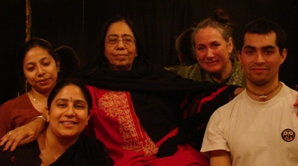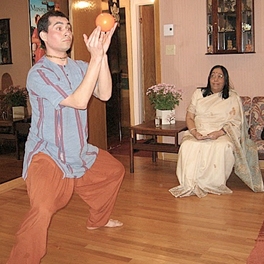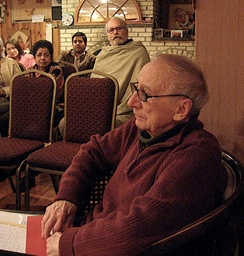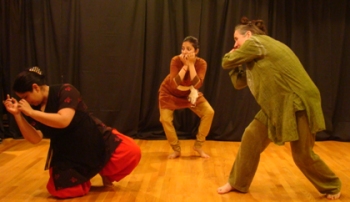
|   |

|   |
A rendezvous with the Animal Kingdom on World Dance Day - Michel Laverdière, Montreal e-mail: laverdiere@sympatico.ca May 21, 2011  Amid all the chatter of animal ethicists calling for a change to reform language - shunning the use of similes such as “eat like a pig”, “ drunk like a skunk”, “sly as a fox”, “ breeding like rabbits” and so on, the World Dance Day presentation with the theme Inspired by the Animal Kingdom did at first seem a happy coincidence. But as we settled into our seats at the le Niketan studio in Montréal on the 30th April to listen to and witness the creative process of some dancers from Kala Bharati and Théâtre de la Source, working with the Indian dance idiom, we realized that this was going to be personal narratives of how these artists have been passionately involved in incorporating the depiction of various animal characters and movements in their dance creations with compassion, humour and imagination.  In the first segment, Mamata Niyogi-Nakra, Founder –Artistic Director of Kala Bharati, briefly traced her own sojourn into the Animal Kingdom. With demonstration by Elias (Ekanath) Vidaurre, a contemporary dancer from Chile, who is presently learning Bharatanatyam from her, Mamata unveiled the creative process of a piece At the Circus. This was conceived and created for Elias, with input from him, as part of the project Jeunesse Volontaire and is being presented to students in Montreal schools as part of the programme Culture à l'école. In this piece Elias' skills in jugglery, yoga and dance came fully into play with great success. Mamata incisively pointed out how she had taken pains to depict the animals, be it the cat or the hen, with qualities that make them appear more wholesome. For example we saw the ever comical monkey, after eating a banana with glee, throws the peel thoughtlessly over his head, then he realizes his mistake right away and picks up the skin and deposits it in a garbage bin and then bursts out clapping in self applause. The infamous crocodile, usually depicted as a mean creature searching for a prey, grabs hold of a member of the audience to befriend and dance with him. Not only was this engaging and amusing, thus making it highly entertaining for young audiences, we had an insight into the process in which Mamata has derived much inspiration from the animal world to make it remarkably educative. We glimpsed shades of Mamata's monumental work Shishu Sadhana in this segment.  This demonstration was followed by an illuminating talk by the writer and journalist, Brian Selwood, who is well versed in all things Indian. Brian spoke on Alfred Williams, an English poet from his hometown of Swindon in the UK. Amongst his many achievements, Williams learnt Sanskrit to translate the Panchatantra. Brian outlined the salient features of his life and times, from his humble beginnings, rising to become an icon important enough to have a musical produced on him and his accomplishments. Brian concluded by pointing out how, amongst the paintings of the influential artist, Jamini Roy, whom he had met during one of his visits to India, there are quite a few that are paintings of animals. Brian also referred to the poignant way in which Pandit Nehru has written quite a few pages on his encounters and coexistence with animals of the yard during the time he spent in a prison. Brian's exposé was quite a revelation for many and served as an interesting lead to the final part of the evening's presentation The Crocodile and the Monkey. Sylvi Belleau, a well known story teller, trained in Kathakali at Kerala Kalamandalam, Renu Chitra, a Kala Bharati trained Bharatanatyam dancer and teacher and Poulomee Bose, a Bharatanatyam dancer, presently taking lessons from Mamata and Renu, presented an extract from their multidisciplinary work in progress based on a story from The Panchatantra... In her introduction, Sylvi drew parallels between Panchatantra and other fables from the west by Fontaine, Aesop, etc. The three artists gave an insight into their personal interest in the animal kingdom that has inspired them to work on this particular piece. Taking inspiration from the story The Monkey and the Crocodile, they choreographed a short piece integrating abhinaya, dance movements and theatre in order to explore the blending of different performance techniques they have studied. All three made the characters come alive thus rendering the story with much élan and finesse.  At the end, the three performers invited the audience to give their feedback to the short presentation as that would enable them with the creative process for the final production. A lively discussion ensued as several inputs poured in, all of them pertinent as well as relevant: that the friendship between the crocodile and monkey be portrayed more feelingly by exuding joy, the demarcation between the crocodile dancing in the water and monkey on land be more clearly defined, vary to a greater degree the moods of the characters, the appropriateness of how the gun was used by the hunter, should the hunter come in with a bow and arrow to reflect the times it was written in and so on. The well known ballet dancer and dance historian Vincent Warren's comments at the very end reminded us that there have been ballets inspired by the Animal Kingdom too, Swan Lake, Firebird, but they mostly are the winged creatures that figured in the ballets of the West and one is left to wonder why that may be. Images of Nathalie Portman's award winning performance in ‘Black Swan' swarmed in my mind's eyes. Yes, there are paintings, music, dance, writings inspired by the Animal Kingdom and then there are the films which we cannot forget!!! Michel Laverdiere of Octave Musique is a well known figure in Montreal's artistic and cultural scene. He has been involved in several creative and innovative initiatives in the field of music, the latest of which Edgar et ses fantômes has met with great success. Michel's association with Kala Bharati, the internationally well known cultural organization in Montreal, spans three decades. Ever since its inception, he has multi-tasked for Kala Bharati in many different roles but the one that stands out is that of the Stage Manager for all except two presentations of Kala Bharati shows. |